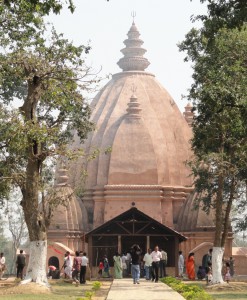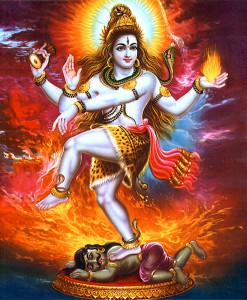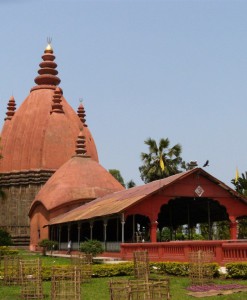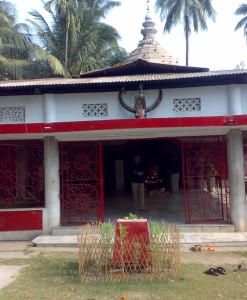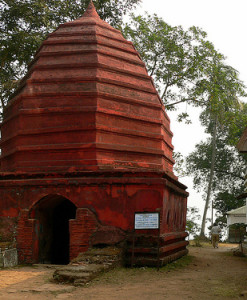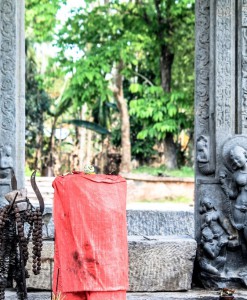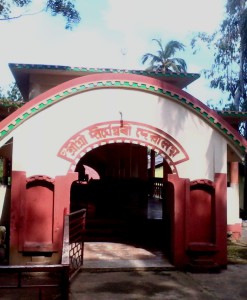No products in the cart.
Sivasagar Sivadol is a group of structures comprising three Hindu temples of Sivadol, Visnudol and Devidol, other shrines, and a museum. These are located on the banks of the Sivasagar tank, also known as the Borpukhuri tank. The tank was constructed between 1731 and 1738 and the temples were built in 1734 by Bar Raja Ambika, queen of Ahom king Swargadeo Siba Singha (1714–1744). The height of the Sivadol (dol means temple in Assamese) is 104 feet (32 m) and the perimeter is 195 feet (59 m) at the base. It is crowned with an 8-foot (2.4 m) high golden-dome.
Sivadol, Sibsagar;
- Temple History
- Architecture
- How To Reach The Temple
- Daily Poojas And Festivals
- Videos
- Additional Information
Sibsagar, present day Sivasagar, was the capital of Ahom kingdom. The Ahoms had migrated from South China in 1228 and established their first capital at Charaideo 28 kilometres (17 mi) from present day Sivsagar in 1253. Initially they were Buddhists, though Hinduism came to prevail. It was the capital of the Ahom Kingdom till the British Raj was established in India. The tank was constructed between 1731 and 1738 and the temples were built in 1734 by Bar Raja Ambika, queen of Ahom king Swargadeo Siba Singha.
The Sivadol or Shiva temple, built in the Shikhara architecture (more specifically Ahom temple architecture), has a central tower which is said to be the tallest tower in India at a height of 104 feet (32 m). The base of the temple measures 195 ft (59 m) in circumference. The temple is built with stone and bricks. Inside the Garbhagriha(sanctum sanctorium), the Shiva Linga (aniconic symbol of Shiva) is deified, which is in a reverse setting. The Shikhara or Vimana (temple tower), which rises above the sanctum sanctorium, has a four-tiered, 8 feet (2.4 m) mastaka and is crowned by a kalasha made of gold.
The tower itself is built with parallel ridges and furrows. The lower part of the tower is flanked by four smaller identical towers, which are known as the angashikaras. The garbagriha, where the main deity is deified in the form of a reversed Shiva linga, is interconnected with an antarala, a small antechamber, which has a roof known as do-chala, which is akin to a typical hut built in Assam. The antarala is also connected to one of the mandapas (outdoor halls). The exterior walls of the temple are embellished with sculptures and floral designs set in Bas-relief.
Some of the unique sculptures set on the outer walls of the temple are of the goddess Durga, which are seen carved with 2 arms, 4 arms, 6 arms, 10 arms and 16 arms. The sixteen armed Durga holding various weapons is a “pan-Himalayan” theme adopted in plastic arts of Ahom temple architecture. Durga is depicted decimating Mahishasura, the demon king with a buffalo head, by thrusting a spear. She is riding a lion, her mount, which supports her in the fight with the demon. This feature represents the harmonious blend of brahminical Hindu culture with the Shaktism cult which the royalty of Ahom dynasty had adopted as their religious practice throughout their kingdom.
By Road: The Temple is easily accessible by road, rail and air services. Guwahati, the capital of Assam, is 370 kilometres (230 mi) away to its northwest and regular deluxe buses operate from here.
By Rail: Simaluguri is the nearest rail head, which is 16 kilometres (9.9 mi) away.
By Air: The nearest airport is at Jorhat, which is 55 kilometres (34 mi) away.
The most important festival celebrated in this temple is Mahashivaratri, which falls in the month of Phagun, a fortnight before Holi (usually a moonless night in February or March). Mahashivaratri is a celebration of the union of Lord Shiva with Parvati. On this day, thousands of devotees come to offer fruits, flowers and bel leaves on the Shivalingam. The main ritual during this festival is the offering of six items on the lingam, namely milk, yoghurt, honey, ghee, sugar, water (Panchamrit) and finally, vermilion paste. This is followed by placing bilwa (bel leaves) on the lingam and offering jujube fruit, as it is a symbol of gratitude. Besides this, other rituals include burning lamps and incense sticks, ringing the bells in the temple, etc. Another important occasion is the festival of Shivratri, celebrated on the 13th night of every month, in the Krishna Paksha.
The Sivasagar tank, also known as the Borpukhuri tank, was built by constructing embankments and the water level thus created in the lake remains above the adjoining ground level. The lake has a total area of 257 acres (104 ha) with a water spread of 129-acre (52 ha). It is said that the lake water remains stable throughout the year without any fluctuations even during the monsoon months. The depth of water in the lake is 27 feet (8.2 m). Many notable structures have been built on the banks of the lake. Three Hindu temples Sivadol, Visnudol and Devidol, a Buddhist shrine and a bird watching tower to watch wintering birds visiting the area, are located on its east bank. The Tai Museum located on the west bank of the tank is built with red bricks. A church and two mosques are also located on the bank of the tank.




